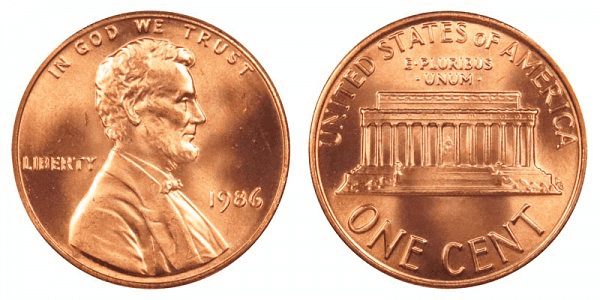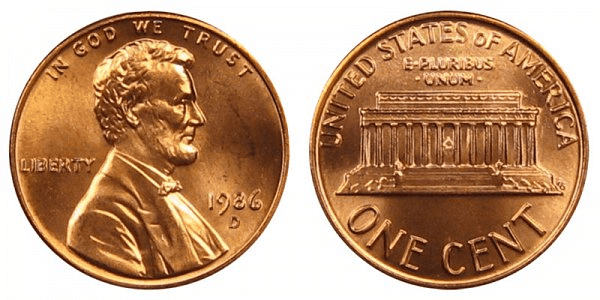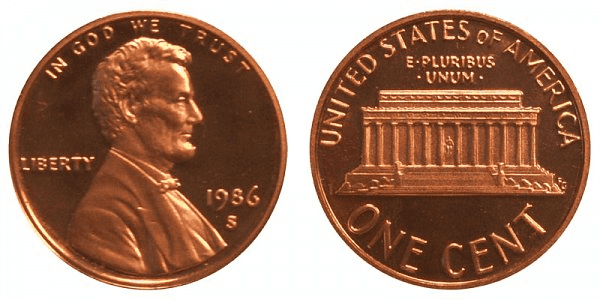What Is the 1986 Penny Made Of?
The 1986 Lincoln Penny is very contemporary in terms of coin collection, and it is frequently found in change. The 1986 penny’s value is decided by its sentimental value unless it’s a rare mistake coin. One of the most fascinating aspects of coins and coin collections is their capacity to serve as a record of historical occurrences that occurred in a particular year.
Additionally, they can be used as a keepsake for someone who was born in that year or who experienced a significant life event in that year.
The 1909 Brenner wheat stalk design that featured on the 1986 cent was replaced with the 1959 Lincoln Memorial reverse created by Frank Gasparro. Gasparro’s initials, FG, can be seen on the lower right side of the Lincoln Memorial.
While the words “UNITED STATES OF AMERICA” are printed all the way around the upper portion of the reverse along the rim, the words “ONE CENT” are written beneath the structure and around the rim.
Between the words, UNITED STATES OF AMERICA and the top of the Lincoln Memorial is written the motto E PLURIBUS UNUM. The edge of the Lincoln cent is simple and without any engraving or reeding.
In 1982 the metal composition of the Lincoln Penny changed to reflect changing values in metal. This means that the 1986 Lincoln Penny has a 97.5% Zinc and 2.5% Copper composition, instead of the nickel and copper combination seen previously.
1986 was a catastrophic year, with the Chernobyl powerplant disaster changing the world forever. 1986 also saw the tragic Challenger shuttle disaster, and the closest Halley’s comet had ever come to Earth.
1986 Penny Varieties
1986 No Mint Mark Penny
Year: 1986
Face Value: $0.01
Composition: 97.5% zinc, 2.5% copper
Total Weight: 2.5g
Diameter: 0.750 in. 19.05 mm
Thickness: 0.0598 inches (1.52 mm)
Edge: Plain
Minted in: Philadelphia (Philadelphia did not mint mark their pennies at this time)
Quantity Minted: 4,491,395,493

photo source: www.usacoinbook.com
1986-D Penny
Year: 1986
Face Value: $0.01
Composition: 97.5% zinc, 2.5% copper
Total Weight: 2.5g
Diameter: 0.750 in. 19.05 mm
Thickness: 0.0598 inches (1.52 mm)
Edge: Plain
Minted in: Denver
Quantity Minted: 4,442,866,698

photo source: www.usacoinbook.com
1986-S Proof Penny
Year: 1986
Face Value: $0.01
Composition: 97.5% zinc, 2.5% copper
Total Weight: 2.5g
Diameter: 0.750 in. 19.05 mm
Thickness: 0.0598 inches (1.52 mm)
Edge: Plain
Minted in: San Francisco
Quantity Minted: 3,010,497

photo source: www.usacoinbook.com
List Of 1986 Penny Errors
Doubled Die
On the obverse and reverse of some 1986 pennies, there is very slight doubling. These can be located by keeping an eye out for doubling in specifics like the inscriptions, dates, Lincoln’s eye and bowtie, as well as between the Lincoln Memorial’s columns.
The average 1986 doubled die penny is worth between $25 and $50, however examples with spectacular doubling and in excellent condition can be worth much more.
BIE Error
Die wear and cracking will occur after striking countless numbers of Lincoln coins. Die breaks and cracks can produce very collectable variants, such as the “BIE” variety, which is exclusive to the Lincoln cent. It happens when a tiny, vertical die crack emerges in the word “LIBERTY” between the letters “B” and “E.” The so-called “BIE” variant was created by certain die cracks that resemble the capital letter “I.”
Depending on the size of the “I” die crack and the condition of the coin, these sell for typically $5 to $15.
How Much Is 1986 Penny Worth Today?
1986 Lincoln Pennies have a melt value of around its face value, meaning there’s no intrinsic metal value to be seen with these coins. Unless there’s something special about them, circulated pennies aren’t worth more than their face value.
| Coin | Condition
|
Value |
| 1986 No Mint Mark Penny | Uncirculated | Typically, an uncirculated 1986 penny is valued between 10 and 20 cents.
Furthermore, 1986 Lincoln cents that are particularly fine and have superior surfaces and are nearly faultless are worth significantly more. For instance, a specimen rated MS68+RD by Professional Coin Grading Service and sold for $2,400 in 2019 set a record price for a 1986 penny. |
| 1986-D Penny
|
Uncirculated | The value of these Lincoln pennies in mint condition ranges from 10 to 20 cents.
In actuality, some of the nicest specimens fetch far higher prices. The 1986-D penny currently has a record price of $1,800. This was the price paid in 2020 for a specimen that Numismatic Guaranty Corporation rated as MS69. |
| 1986-S Proof Penny | Proof | With this unique proof technique of manufacture, the U.S. Mint produced a relatively modest quantity of 1986 pennies at the San Francisco Mint. The majority of the 3,792,233 proof pennies produced in 1986 are worth between $1 and $3.
One of the finest 1986-S proof pennies was rated as PR70DCAM by Professional Coin Grading Service and sold for a record $3,450 in 2003. |
How Does The Grading System Work?
The Sheldon Scale is used by numismatists to provide a numerical value to coins. The Sheldon Scale goes from poor (P-1) to perfect mint state (P-1) (MS-70). Coins were originally evaluated using words to reflect their condition (Good, Fair, Excellent, Etc.). Unfortunately, coin collectors and dealers had different ideas about what each of these terms represent.
Professional numismatists joined together in the 1970s and established CoinGrading standards. These numismatists now assign grades at key places on the seventy-point scale, using the most regularly utilized numeric points in conjunction with the original adjective grade. The following are the most common coin grades:
-
-
- (P-1) Poor – Indistinguishable and probably damaged; if used, must have a date and mintmark; otherwise, rather battered.
- (FR-2) Fair – Nearly smooth, but without the damage that a coin graded Poor often possesses. The coin must have enough detail to be identified.
- (G-4) Fair – Inscriptions have merged into the rims in some areas, and important elements have been mostly erased.
- (VG-8) Very Good- A little weathered, but all of the primary design elements are visible, albeit faintly. There is little if any, central detail left.
- (F-12) Good – The item is very worn, yet the wear is even, and the overall design details stand out clearly. Rims are almost completely isolated from the field.
- (VF-20) Very Fine – Moderately weathered, with some finer features still visible. The motto or all letters of LIBERTY are readable. Both sides of the coin have entire rims that are separated from the field.
- (EF-40) Extremely Fine – Gently used; all gadgets are visible, and the most important ones are bold. The finer details are bold and clear, however, light wear may be seen.
- (AU-50) Uncirculated – Slight evidence of wear on the coin’s design’s high points; may have contact marks; eye appeal should be adequate.
- (AU-58) Uncirculated Choice – Slight traces of wear, no severe contact marks, almost full mint shine, and great eye appeal.
- (MS-60) Mint State Basal – Strictly uncirculated; no indication of wear on the coin’s highest points, but an unsightly coin with reduced luster, visible contact marks, hairlines, and other flaws.
- (MS-63) Mint State Acceptable – Uncirculated, but with contact scratches and nicks, little reduced shine, but otherwise appealing appearance. The strike is weak to average.
- (MS-65) Mint State Choice – Uncirculated with great mint shine, very little contact blemishes, and exceptional eye appeal. The strike is unusually severe.
- (MS-68) Mint State Premium Quality – Uncirculated with superb luster, no obvious contact marks to the naked eye, and exceptional eye appeal. The strike is quick and appealing.
- (MS-69) Almost Perfect Mint State – Uncirculated with perfect brilliance, a sharp and appealing strike, and extremely good eye appeal. A near-perfect coin with minor imperfections in the planchet, strike, and contact markings (seen only under 8x magnification).
- (MS-70) Mint State Perfect – Under 8x magnification, there are no tiny imperfections discernible; the strike is crisp, and the coin is perfectly centered on a beautiful planchet. Rarely seen on a coin, this coin is bright and whole, with original luster and exceptional eye appeal.
-
Where To Buy Or Sell 1986 Penny?
Flea markets, estate sales, and online marketplaces like eBay are the ideal places to get 1986 Pennies by the roll because they are mostly regarded as a novelty or sentimental coins for those who were born in the year, got married in the year, or had other major events occur in the year.
Working with trustworthy coin dealers and auction houses (like Heritage Auctions) is essential for added peace of mind when dealing with unique or rare coins, such as the 1986 Pennies with defects or those in fantastic condition. Ask for advice in online communities for coins if you’re unsure whether your penny has a more valuable mint flaw or not.
FAQs
What penny is worth over $1000?
The Lincoln Pennies that reach into the hundreds or thousands of dollars are those of absolute mint quality such as those that are MS68 and high or PR70.
What Lincoln penny is the rarest to collect?
One of the most mysterious coins in American numismatics is the 1943 copper alloy cent, which is also rumoured to be the most expensive Lincoln penny ever.
Is there a 1986 silver penny?
There were no 1986 silver pennies minted, any coin which shows a silver tone is either an exceptionally rare undiscovered error, or the copper cladding of the coin has been removed, revealing the silver zinc core of the coin.



